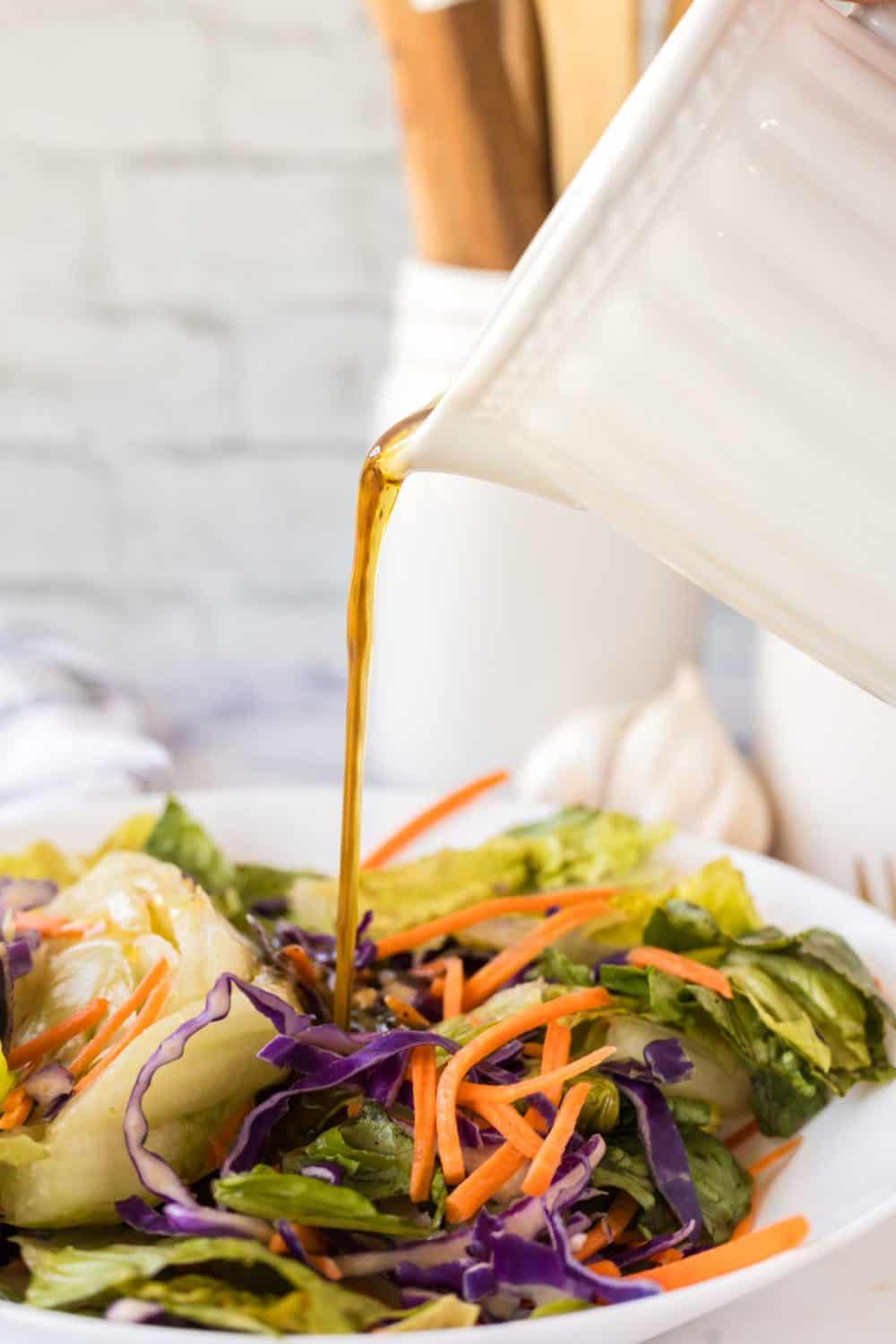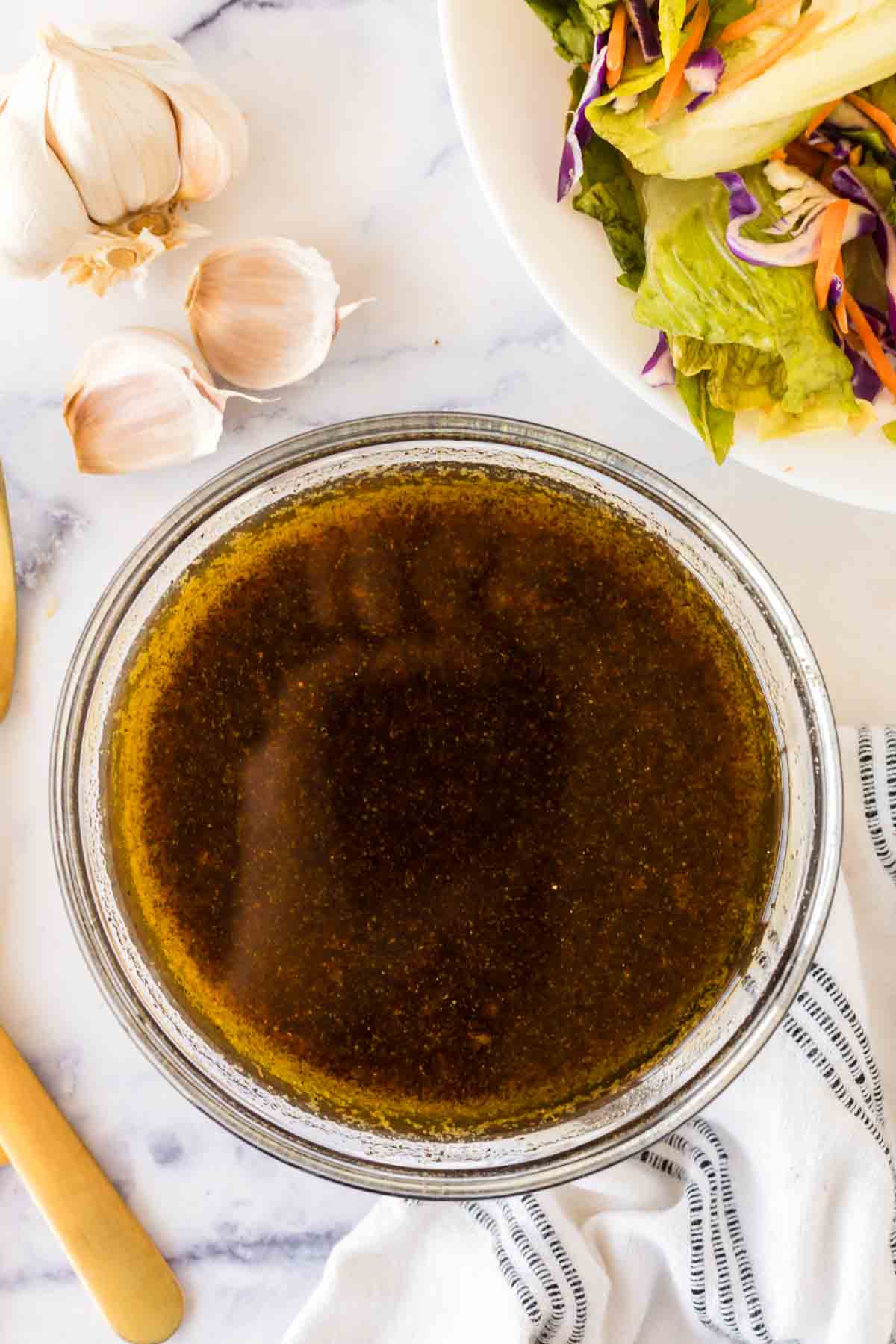Balsamic Vinaigrette
on Jan 11, 2024, Updated Sep 04, 2024
This post may contain affiliate links. Please read our disclosure policy.
Tangy Balsamic Vinaigrette comes together with olive oil, honey, Dijon mustard, and some simple spices to bring you the best homemade balsamic vinaigrette!

I love a good balsamic vinaigrette because it can be used in so many different ways, including on my easy Caprese Salad! It pairs perfectly with cheese and nuts, so I tend to serve it with salads that feature feta, goat cheese, mozzarella, pecans, or walnuts. My beet salad with feta would taste divine with this vinaigrette, as well as my shaved Brussels Sprout Salad. I absolutely love pairing this tangy and rich dressing with a light and fruity strawberry and pecan spinach salad!
Not a big fan of leafy greens? You can also use this homemade balsamic vinaigrette as a glaze for roasted vegetables. Try drizzling some over easy brussels sprouts before popping them in the oven. As your vegetables soften, they will soak up all the tangy and robust flavors of this simple salad dressing.
This vinaigrette will last in the fridge for a few weeks so you can experiment with different ways to serve it! Truly, the sky’s the limit when it comes to this 10-minute homemade salad dressing.
Table of Contents

Why You’ll Love This Recipe
- Extremely versatile.
- Has a wonderful combination of flavors.
- A sophisticated dressing that you can make right in your own home!
- Only uses a handful of pantry ingredients and can be adjusted to your liking.
Recipe Ingredients

- Balsamic vinegar—The base of the dressing. Provides a robust and tart taste!
- Olive oil—Balance the acidity of the vinegar.
- Dijon mustard—Helps to emulsify the vinaigrette.
- Honey—Adds a sweet element to the dressing.
- Seasoning Mix—A combination of salt, pepper, and garlic powder.
See the recipe card for full information on ingredients and quantities.
How to Make Balsamic Vinaigrette


Step #1. Gather all of your ingredients and measure them out according to the recipe.
Step #2. Whisk all of the ingredients together in a large bowl until smooth and homogenous. Make sure the Dijon mustard is thoroughly combined.


Step #3. Make sure the Dijon mustard is thoroughly combined.
Step #4. Store your dressing in the fridge until you are ready to use it. Serve and enjoy!
Recipe FAQs
Traditional balsamic vinegar originates from Modena, Italy. It is made by pressing sweet white grapes as a whole, and then cooked over a flame until the liquid has been reduced. After that, the liquid is left to ferment and oxidize which gives it the dark brown color and the rich taste. This ingredient is highly regulated for quality and is a staple in Italian cuisine.
There are many different ways to describe the complex flavors of balsamic vinaigrette! Because of the vinegar, it has a rich and robust taste. When mixed with the other ingredients, it develops a slightly sweet yet still tangy flavor. With all of these flavors, balsamic vinaigrette is a great dressing that goes well with salads, sandwiches, or roasted vegetables.

Expert Tips
- The sweetness of the honey will help balance the sharpness of the Dijon mustard and garlic powder! If you don’t have honey, you can use maple syrup instead.
- It is important to whisk the vinaigrette thoroughly. You don’t want to have any small clumps of Dijon mustard floating in your mixture!
- As the dressing sits in the fridge, the flavors will come together more, meaning this vinaigrette often tastes better after it has been in the fridge for a day or two!
- Try to use extra virgin olive oil for best results! If you don’t have any, you can use whatever oil you have available.
- You can adjust the measurements or add spices according to your taste! Feel free to play around with it and find the best balance that works for you.

How to Serve Balsamic Vinaigrette
- Drizzle it on top of salad: this works wonderfully as a dressing on almost any salad! The tanginess of the vinaigrette goes well with fruit, nuts, and creamy cheeses. You can use it to dress a strawberry and pecan spinach salad or caprese salad!
- Use it as a marinade: some people like to pair balsamic vinaigrette with fish, chicken, or turkey for a sophisticated and fancy tasting dish!
- Toss it over roasted vegetables: the rich and slightly sweet taste of this vinaigrette pairs well with many seasonal vegetables such as brussel sprouts, squash, or green beans.
- Use it as a dip: you can dip grilled cheese with pesto, chicken paninis, or just plain French bread in this dressing!
How to Store Balsamic Vinaigrette
This vinaigrette is best stored in an airtight mason jar but you can also use a Rubbermaid container. Be sure to store this dressing in the fridge, and it will be good for up to 2 weeks! Once you are ready to use it again, give it a good shake as the oil and vinegar might separate slightly while it sits in the fridge.
More Condiments To Consider
Simple Gingerbread Recipes
Homemade Gingerbread Syrup: Cozy Holiday in a Bottle
Condiments, Marinades & Spreads
Easy Homemade Red Enchilada Sauce
Pasta Dishes
Pumpkin Alfredo
Did you make this recipe? Leave a ⭐️ review and share it on Instagram, Facebook, or Pinterest!

Balsamic Vinaigrette
Ingredients
- 1/2 cup balsamic vinegar
- 1/2 cup olive oil
- 2 tablespoons Dijon mustard
- 1 tablespoon honey
- 1 teaspoon salt
- 1 teaspoon pepper
- 1 teaspoon garlic powder
Instructions
- Whisk all of the ingredients together in a large bowl until smooth and homogenous. Make sure the Dijon mustard is thoroughly combined.
- Store your dressing in the fridge until you are ready to use it.
- Serve and enjoy!
Notes
- You can use this vinaigrette as a dressing or a dip. It is great drizzled over a homemade salad or as a side with some veggies and slices of French bread.
- This vinaigrette is best stored in an airtight mason jar but you can also use a Rubbermaid container. You can store this dressing for up to two weeks in the fridge.
- The sweetness of the honey helps balance the sharpness of the Dijon mustard and garlic powder.
- Use extra virgin olive oil if you have it. If not you can use whatever olive oil you have available.
- It is important to whisk your vinaigrette thoroughly. You don’t want to have any small clumps of Dijon mustard floating in your mixture.
- As the dressing sits in the fridge the flavors will come together more, meaning this vinaigrette often tastes better after it has been in the fridge for a day or two. It also might solidify so just take it out of the fridge a few hours before using.














